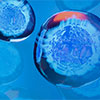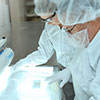Cloning+Kits+and+Ligation
Supplier:
Enzo Life Sciences
Description:
CD40 is a 45-50 kDa type I membrane protein and a member of the tumor necrosis factor (TNF) receptor superfamily. CD40 is also known as pb50 or CDW40. CD40 is expressed primarily by professional antigen-presenting cells and it is also expressed on non-immune cell types. The CD40 expressed by professional antigen-presenting cells plays a critical role in co-stimulation and antigen-presenting cell activation in T cell-dependent immune responses. Signals generated through CD40 in B cells are anti-apoptotic. These signals are also required for T cell-dependent B cell activation and proliferation, isotype switching, up-regulation of costimulatory receptors, germinal center formation and memory generation. CD40 signal transduction is initiated by binding trimeric CD40 ligand (CD40L) which is found on the surface of activated T cells. CD40 engages several signalling pathways in B cells and these include NF-kB, the mitogen-activated protein kinases p38 and c-Jun N-terminal kinase. The 62 amino acid cytoplasmic domain (CD40c) of CD40 contains two linear TNF-receptor associated factor (TRAF) binding domains. The membrane proximal site of CD40c binds TRAF6 and the membrane distal site binds TRAF1, 2 and 3. CD40c is thought to mediate the CD40-dependant signalling pathways by recruitment of TRAF to this multimerized domain. CD40 ligation has also been shown to stimulate iNOS expression, and therefore NO production, by activating NF-kB in IFN-g treated microglial cells. NO derived from microglia has been implicated in the damage of myelin-producing oligodendrocytes in demyelinating disorders like multiple sclerosis (MS) and neuronal death during Alzheimer’s disease and brain trauma. Increased CD40-CD40 ligation has been implicated in the pathogenesis of several autoimmune inflammatory diseases, such as MS, arthritis and insulin-dependant diabetes.
Catalog Number:
(75794-246)
Supplier:
Prosci
Description:
Human CD137 (4-1BB) is a costimulatory molecule of the tumor necrosis factor (TNF) receptor superfamily. The glycoprotein 4-1BB is expressed mainly on activated CD4+ and CD8+ T cells and binds to a high-affinity ligand (4-1BBL) expressed on several antigen-presenting cells such as macrophages and activated B cells. Upon ligand binding, 4-1BB is associated with the tumor receptor-associated factors (TRAF), the adaptor protein and mediates downstream signaling events including the activation of NF-kappaB and cytokine production. 4-1BB signaling either by binding to 4-1BBL or by antibody ligation delivers signals for T cell activation and growth as well as monocyte proliferation and B cell survival, and plays a important role in the amplification of T cell-mediated immune responses. In contrast, it can also enhance activation-induced T cell apoptosis when triggered by engagement of the TCR/CD3 complex. In addition, the 4-1BB/4-1BBL costimulatory pathway has been shown to augment secondary CTL responses to several viruses and increase antitumor immunity. 4-1BB is therefore a promising candidate for immunotherapy of human cancer.
Catalog Number:
(10423-984)
Supplier:
Bioss
Description:
Serine-threonine kinase which transduces inflammatory and cell-death signals (programmed necrosis) following death receptors ligation, activation of pathogen recognition receptors (PRRs), and DNA damage. Upon activation of TNFR1 by the TNF-alpha family cytokines, TRADD and TRAF2 are recruited to the receptor. Phosphorylates DAB2IP at 'Ser-728' in a TNF-alpha-dependent manner, and thereby activates the MAP3K5-JNK apoptotic cascade. Ubiquitination by TRAF2 via 'Lys-63'-link chains acts as a critical enhancer of communication with downstream signal transducers in the mitogen-activated protein kinase pathway and the NF-kappa-B pathway, which in turn mediate downstream events including the activation of genes encoding inflammatory molecules. Polyubiquitinated protein binds to IKBKG/NEMO, the regulatory subunit of the IKK complex, a critical event for NF-kappa-B activation. Interaction with other cellular RHIM-containing adapters initiates gene activation and cell death. RIPK1 and RIPK3 association, in particular, forms a necrosis-inducing complex.
Catalog Number:
(77440-566)
Supplier:
Bioss
Description:
CTU2 is a 515 amino acid cytoplasmic protein that plays a role in the 2-thiolation of mcm(5)S(2)U at wobble positions of tRNA. CTU2 forms a complex with CTU1 and Urm1, and may also form a separate heterodimer with CTU1 to ligate sulfur from thiocarboxylated Urm1 onto tRNA. Existing as three alternatively spliced isoforms, the gene encoding CTU2 maps to human chromosome 16q24.3. Chromosome 16 encodes over 900 genes and comprises nearly 3% of the human genome. The GAN gene is located on chromosome 16 and, with mutation, may lead to giant axonal neuropathy, a nervous system disorder characterized by increasing malfunction with growth. The rare disorder Rubinstein-Taybi syndrome is also associated with chromosome 16, as is Crohn's disease, which is a gastrointestinal inflammatory condition.
Catalog Number:
(76079-854)
Supplier:
Bioss
Description:
DNA repair enzyme that can remove a variety of covalent adducts from DNA through hydrolysis of a 5'-phosphodiester bond, giving rise to DNA with a free 5' phosphate. Catalyzes the hydrolysis of dead-end complexes between DNA and the topoisomerase 2 (TOP2) active site tyrosine residue. Hydrolyzes 5'-phosphoglycolates on protruding 5' ends on DNA double-strand breaks (DSBs) due to DNA damage by radiation and free radicals. The 5'-tyrosyl DNA phosphodiesterase activity can enable the repair of TOP2-induced DSBs without the need for nuclease activity, creating a 'clean' DSB with 5'-phosphate termini that are ready for ligation. Has also 3'-tyrosyl DNA phosphodiesterase activity, but less efficiently and much slower than TDP1. May also act as a negative regulator of ETS1 and may inhibit nuclear factor-kappa-B activation.
Catalog Number:
(10423-986)
Supplier:
Bioss
Description:
Serine-threonine kinase which transduces inflammatory and cell-death signals (programmed necrosis) following death receptors ligation, activation of pathogen recognition receptors (PRRs), and DNA damage. Upon activation of TNFR1 by the TNF-alpha family cytokines, TRADD and TRAF2 are recruited to the receptor. Phosphorylates DAB2IP at 'Ser-728' in a TNF-alpha-dependent manner, and thereby activates the MAP3K5-JNK apoptotic cascade. Ubiquitination by TRAF2 via 'Lys-63'-link chains acts as a critical enhancer of communication with downstream signal transducers in the mitogen-activated protein kinase pathway and the NF-kappa-B pathway, which in turn mediate downstream events including the activation of genes encoding inflammatory molecules. Polyubiquitinated protein binds to IKBKG/NEMO, the regulatory subunit of the IKK complex, a critical event for NF-kappa-B activation. Interaction with other cellular RHIM-containing adapters initiates gene activation and cell death. RIPK1 and RIPK3 association, in particular, forms a necrosis-inducing complex.
Catalog Number:
(10423-992)
Supplier:
Bioss
Description:
Serine-threonine kinase which transduces inflammatory and cell-death signals (programmed necrosis) following death receptors ligation, activation of pathogen recognition receptors (PRRs), and DNA damage. Upon activation of TNFR1 by the TNF-alpha family cytokines, TRADD and TRAF2 are recruited to the receptor. Phosphorylates DAB2IP at 'Ser-728' in a TNF-alpha-dependent manner, and thereby activates the MAP3K5-JNK apoptotic cascade. Ubiquitination by TRAF2 via 'Lys-63'-link chains acts as a critical enhancer of communication with downstream signal transducers in the mitogen-activated protein kinase pathway and the NF-kappa-B pathway, which in turn mediate downstream events including the activation of genes encoding inflammatory molecules. Polyubiquitinated protein binds to IKBKG/NEMO, the regulatory subunit of the IKK complex, a critical event for NF-kappa-B activation. Interaction with other cellular RHIM-containing adapters initiates gene activation and cell death. RIPK1 and RIPK3 association, in particular, forms a necrosis-inducing complex.
Catalog Number:
(10423-990)
Supplier:
Bioss
Description:
Serine-threonine kinase which transduces inflammatory and cell-death signals (programmed necrosis) following death receptors ligation, activation of pathogen recognition receptors (PRRs), and DNA damage. Upon activation of TNFR1 by the TNF-alpha family cytokines, TRADD and TRAF2 are recruited to the receptor. Phosphorylates DAB2IP at 'Ser-728' in a TNF-alpha-dependent manner, and thereby activates the MAP3K5-JNK apoptotic cascade. Ubiquitination by TRAF2 via 'Lys-63'-link chains acts as a critical enhancer of communication with downstream signal transducers in the mitogen-activated protein kinase pathway and the NF-kappa-B pathway, which in turn mediate downstream events including the activation of genes encoding inflammatory molecules. Polyubiquitinated protein binds to IKBKG/NEMO, the regulatory subunit of the IKK complex, a critical event for NF-kappa-B activation. Interaction with other cellular RHIM-containing adapters initiates gene activation and cell death. RIPK1 and RIPK3 association, in particular, forms a necrosis-inducing complex.
Catalog Number:
(75791-164)
Supplier:
Prosci
Description:
Lymphocyte cytosolic protein 2(LCP2)contains a SAM domain and a SH2 domain. It is highly expressed in spleen, thymus and peripheral blood leukocytes, T-cell and monocytic cell lines, but expressed at lower level in B-cell lines. LCP2 was originally identified as a substrate of the ZAP-70 protein tyrosine kinase following T cell receptor (TCR) ligation in the leukemic T cell line Jurkat. It is phosphorylated after T-cell receptor activation by ZAP70, ITK and TXK, which leads to the up-regulation of Th1 preferred cytokine IL-2 during post-translational modification. Studies using LCP2-deficient T cell lines or mice have provided strong evidence that SLP-76 plays a positive role in promoting T cell development and activation as well as mast cell and platelet function.
Catalog Number:
(75794-216)
Supplier:
Prosci
Description:
CD40 Ligand (CD40L), renamed TNFSF5 but now also known as CD154, TRAP and gp39, is a 34-39kDa type II transmembrane glycoprotein that belongs to the TNF superfamily. As with other TNF superfamily members, CD40L will exist as a trimer, both as a membrane bound and soluble form. Multiple mutations and alternate splice forms of CD40L exist, often associated with pathology and leading to truncated or nontrimerizable forms of CD40L. CD40L binds to both CD40 and to integrin alphaIIbbeta3 (CD41). In the cell membrane, it also associates with a unique splice variant of CD28 (CD28i) that may facilitate CD40L signal transduction. CD40L is expressed by monocytes, NK cells, mast cells, basophils, smooth muscle cells, endothelial cells, dendritic cells,activated and resting B cells, plus activated platelets and CD4+ T cells. CD40L ligation of CD40 on dendritic cells (DC) initiates DC maturation and differentiation. CD40L signaling into naive B cells promotes germinal center formation and isotope switching. CD40-CD40L seems to bridge innate and adaptive immune signals.
Catalog Number:
(10409-896)
Supplier:
Bioss
Description:
DNA repair enzyme that can remove a variety of covalent adducts from DNA through hydrolysis of a 5'-phosphodiester bond, giving rise to DNA with a free 5' phosphate. Catalyzes the hydrolysis of dead-end complexes between DNA and the topoisomerase 2 (TOP2) active site tyrosine residue. Hydrolyzes 5'-phosphoglycolates on protruding 5' ends on DNA double-strand breaks (DSBs) due to DNA damage by radiation and free radicals. The 5'-tyrosyl DNA phosphodiesterase activity can enable the repair of TOP2-induced DSBs without the need for nuclease activity, creating a 'clean' DSB with 5'-phosphate termini that are ready for ligation. Has also 3'-tyrosyl DNA phosphodiesterase activity, but less efficiently and much slower than TDP1. May also act as a negative regulator of ETS1 and may inhibit nuclear factor-kappa-B activation.
Catalog Number:
(76120-260)
Supplier:
Bioss
Description:
Structure-specific nuclease with 5'-flap endonuclease and 5'-3' exonuclease activities involved in DNA replication and repair. During DNA replication, cleaves the 5'-overhanging flap structure that is generated by displacement synthesis when DNA polymerase encounters the 5'-end of a downstream Okazaki fragment. It enters the flap from the 5'-end and then tracks to cleave the flap base, leaving a nick for ligation. Also involved in the long patch base excision repair (LP-BER) pathway, by cleaving within the apurinic/apyrimidinic (AP) site-terminated flap. Acts as a genome stabilization factor that prevents flaps from equilibrating into structures that lead to duplications and deletions. Also possesses 5'-3' exonuclease activity on nicked or gapped double-stranded DNA, and exhibits RNase H activity. Also involved in replication and repair of rDNA and in repairing mitochondrial DNA.
Catalog Number:
(10409-894)
Supplier:
Bioss
Description:
DNA repair enzyme that can remove a variety of covalent adducts from DNA through hydrolysis of a 5'-phosphodiester bond, giving rise to DNA with a free 5' phosphate. Catalyzes the hydrolysis of dead-end complexes between DNA and the topoisomerase 2 (TOP2) active site tyrosine residue. Hydrolyzes 5'-phosphoglycolates on protruding 5' ends on DNA double-strand breaks (DSBs) due to DNA damage by radiation and free radicals. The 5'-tyrosyl DNA phosphodiesterase activity can enable the repair of TOP2-induced DSBs without the need for nuclease activity, creating a 'clean' DSB with 5'-phosphate termini that are ready for ligation. Has also 3'-tyrosyl DNA phosphodiesterase activity, but less efficiently and much slower than TDP1. May also act as a negative regulator of ETS1 and may inhibit nuclear factor-kappa-B activation.
Catalog Number:
(10409-898)
Supplier:
Bioss
Description:
DNA repair enzyme that can remove a variety of covalent adducts from DNA through hydrolysis of a 5'-phosphodiester bond, giving rise to DNA with a free 5' phosphate. Catalyzes the hydrolysis of dead-end complexes between DNA and the topoisomerase 2 (TOP2) active site tyrosine residue. Hydrolyzes 5'-phosphoglycolates on protruding 5' ends on DNA double-strand breaks (DSBs) due to DNA damage by radiation and free radicals. The 5'-tyrosyl DNA phosphodiesterase activity can enable the repair of TOP2-induced DSBs without the need for nuclease activity, creating a 'clean' DSB with 5'-phosphate termini that are ready for ligation. Has also 3'-tyrosyl DNA phosphodiesterase activity, but less efficiently and much slower than TDP1. May also act as a negative regulator of ETS1 and may inhibit nuclear factor-kappa-B activation.
Catalog Number:
(76078-554)
Supplier:
Bioss
Description:
Serine-threonine kinase which transduces inflammatory and cell-death signals (programmed necrosis) following death receptors ligation, activation of pathogen recognition receptors (PRRs), and DNA damage. Upon activation of TNFR1 by the TNF-alpha family cytokines, TRADD and TRAF2 are recruited to the receptor. Phosphorylates DAB2IP at 'Ser-728' in a TNF-alpha-dependent manner, and thereby activates the MAP3K5-JNK apoptotic cascade. Ubiquitination by TRAF2 via 'Lys-63'-link chains acts as a critical enhancer of communication with downstream signal transducers in the mitogen-activated protein kinase pathway and the NF-kappa-B pathway, which in turn mediate downstream events including the activation of genes encoding inflammatory molecules. Polyubiquitinated protein binds to IKBKG/NEMO, the regulatory subunit of the IKK complex, a critical event for NF-kappa-B activation. Interaction with other cellular RHIM-containing adapters initiates gene activation and cell death. RIPK1 and RIPK3 association, in particular, forms a necrosis-inducing complex.
Catalog Number:
(10423-970)
Supplier:
Bioss
Description:
Serine-threonine kinase which transduces inflammatory and cell-death signals (programmed necrosis) following death receptors ligation, activation of pathogen recognition receptors (PRRs), and DNA damage. Upon activation of TNFR1 by the TNF-alpha family cytokines, TRADD and TRAF2 are recruited to the receptor. Phosphorylates DAB2IP at 'Ser-728' in a TNF-alpha-dependent manner, and thereby activates the MAP3K5-JNK apoptotic cascade. Ubiquitination by TRAF2 via 'Lys-63'-link chains acts as a critical enhancer of communication with downstream signal transducers in the mitogen-activated protein kinase pathway and the NF-kappa-B pathway, which in turn mediate downstream events including the activation of genes encoding inflammatory molecules. Polyubiquitinated protein binds to IKBKG/NEMO, the regulatory subunit of the IKK complex, a critical event for NF-kappa-B activation. Interaction with other cellular RHIM-containing adapters initiates gene activation and cell death. RIPK1 and RIPK3 association, in particular, forms a necrosis-inducing complex.
Inquire for Price
Stock for this item is limited, but may be available in a warehouse close to you. Please make sure that you are logged in to the site so that available stock can be displayed. If the
Stock for this item is limited, but may be available in a warehouse close to you. Please make sure that you are logged in to the site so that available stock can be displayed. If the
You must log in to order restricted items. We request that you provide the required business documentation to purchase this product for the first time.
To order chemicals, medical devices, or other restricted products please provide identification that includes your business name and shipping address via email CMD_NA@vwr.com or fax 484.881.5997 referencing your VWR account number . Acceptable forms of identification are:
-Additional Documentation May be needed to purchase this item. A VWR representative will contact you if needed.
This product has been blocked by your organization. Please contact your purchasing department for more information.
The original product is no longer available. The replacement shown is available.
This product is currently unavailable but limited stock may be available in our extended warehouse network. Please call 1-800-932-5000 and a VWR Customer Service Representative will help you.
|
|||||||||


































